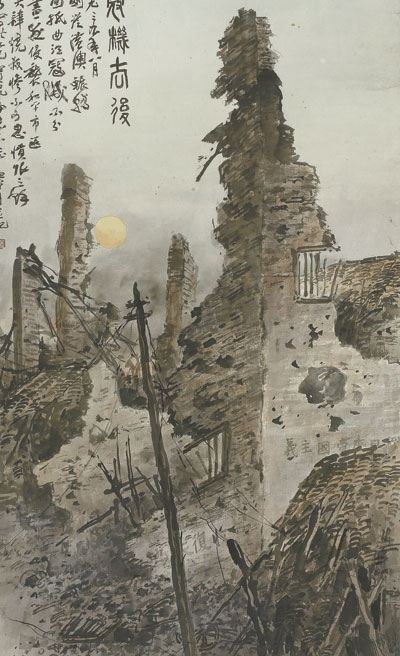
Anna Zhao anna.whizh@yahoo.com MORE than 40 paintings by Guan Shanyue are on a yearlong exhibition at the museum named after him — the Guan Shanyue Art Museum in Futian District — in commemoration of the artist’s dedication to art during wartime. The paintings, created during the 1930s to 1940s, are the embodiment of the artist’s struggle as a freedom fighter during the Japanese invasion. The outbreak of the war against the Japanese invaders in 1937 suddenly posed a new challenge to Chinese art circles when different schools of thought — Oriental and Western — were clashing. It seemed to be a challenging task for artists of traditional Chinese paintings to face reality — portraying landscapes was obviously incongruous with the social reality of the time. How artists could use their brushes to express people’s suffering and boost the morale of the Chinese people who were fighting for their nation became priorities for Chinese artists. Guan was at an ambitious age, studying traditional Chinese painting from his teacher Gao Jianfu in Guangzhou, the capital of Guangdong Province, when the city fell to Japanese invaders in October 1938. Guan and his teacher were forced to seek shelter in Macao. While in exile, Guan felt the cruelty of war and witnessed the suffering of people who were displaced by the war. The young artist responded to the occasion with paintings depicting the war, and his skills gradually matured. “Scene outside Sanzao Island” portrays a port devastated by Japanese bombers. The artist painted an elaborate account of the horrifying scene: flames swallowing the port, smoke billowing, debris flying from damaged boats and people struggling in the water. “Widow and Orphans Displaced by War” and “Zhongshan Refugees” depict the scene of people fleeing their homes during the war. In the painting “End of Invaders,” Guan portrayed a bleak scene after a bombardment by Japanese forces. The painter intended the painting to say that the invaders are doomed to be defeated — a Japanese army helmet and a worn-out Japan flag hang on barbed wire while birds perch on an old tree in the sunset with the ground blanketed in white snow. The scene of devastation imposed by the invaders became a sore in Guan’s eyes; his paintings helped him vent his indignation. In Macao, he created “Withdraw From the City,” a long scroll depicting people’s wretched lives during their migration to a safer place on a snowy winter day after their hometown was destroyed. In January 1940, Guan held his first art exhibition in Macao, with a theme that protested the Japanese invasion. The exhibition soon helped him earn a name in the art community. His paintings ushered in an era of realism in the history of traditional Chinese painting. Chen Junyu, art researcher at the museum, said Guan had succeeded in developing his own skills based on the traditions of the Lingnan School. “Although his character configurations in his early paintings were not good enough, his skills gradually matured,” Chen said. Guan later migrated along a tortuous route from northern Guangdong into Guilin in Guangxi, then southwestward to Sichuan and northward to Gansu Province. In Sichuan, he met many scholars and artists who were also taking refuge from the war. His paintings at that time were often marked by figures of scholars living miserable lives or people working hard to feed themselves. In Gansu, a place far away from the war, Guan directed his attention to the lives of ethnic minorities that were unfazed by the war. His area of focus shifted from water and gardens to people on horseback. His paintings of human figures were often characterized by solid lines indicating people’s physical strength and athletic beauty. To give visitors a better experience, the museum has set up a shelf displaying photo books with stories about the war at the entrance to the second floor of the museum. Also, a war-themed exhibition of posters and videos is being held on the museum’s first floor until Sept. 13. The exhibition includes 25 posters from Belarus focusing on Belarusian people’s fight against Fascism during World War II, five videos about Chinese battlefields during WWII, which were contributed by the Yuezhong Museum of Historical Image, and 60 pictures about Shenzhen’s history of fighting against the Japanese invaders. “The exhibitions are being held to encourage people to cherish peace in their current lives and to continue to work for it and not to recall the memories of blood and pain during war,” said Chen Ping, a researcher at the museum. Dates: Through Aug. 31, 2016 Venue: Guan Shanyue Art Museum, 6026 Hongli Road, Futian District (福田区红荔路6026号关山月美术馆) Metro: Longgang or Longhua Line, Children’s Palace Station (少年宫站), Exit B | 
